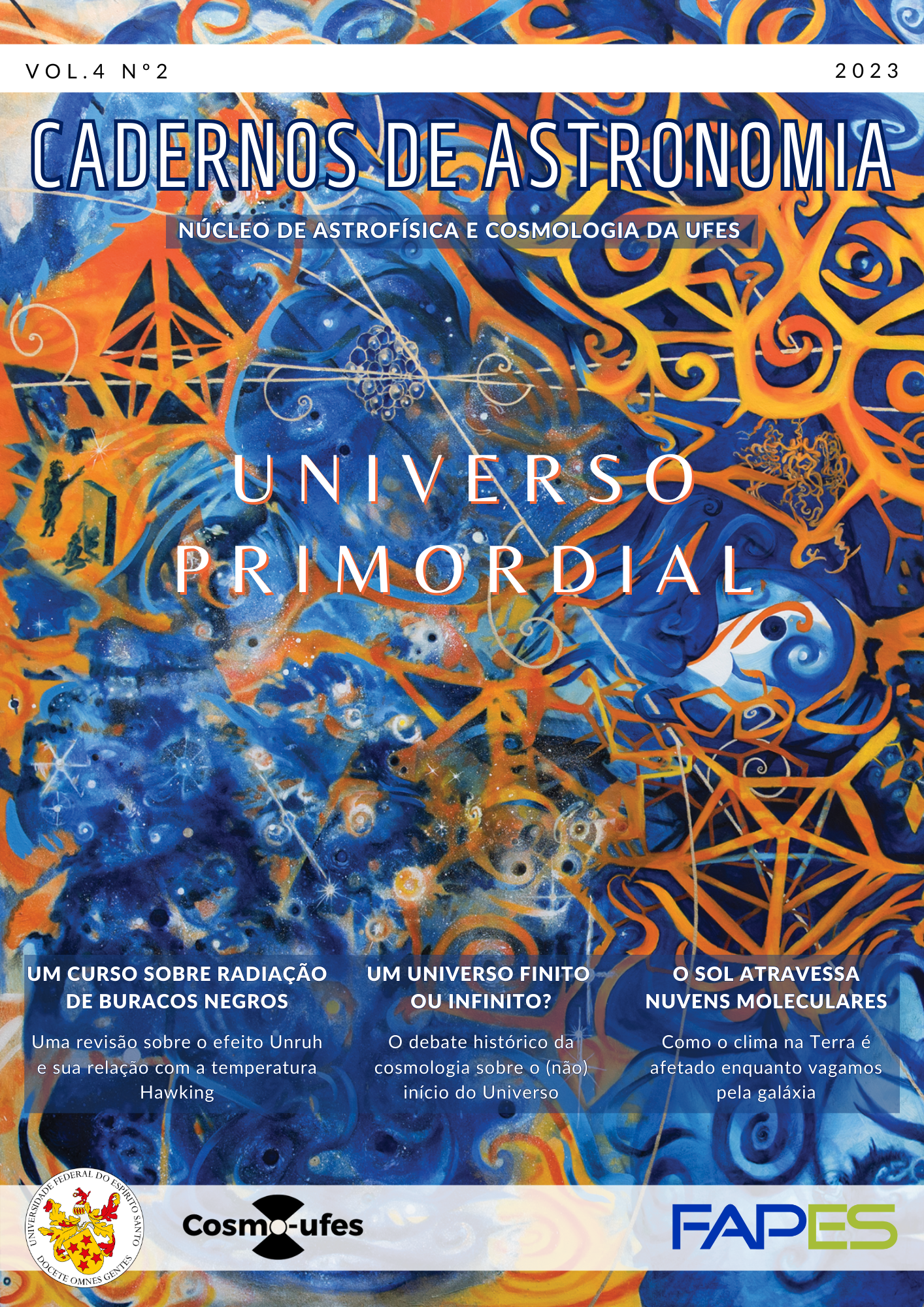O efeito Fulling-Davies-Unruh
DOI:
https://doi.org/10.47456/Cad.Astro.v4n2.42121Palavras-chave:
efeito Unruh, radiação Hawking, teoria quântica de camposResumo
Este texto (revisto e atualizado) é baseado em aulas do curso ``Diferentes Aspectos da Relatividade Geral'', ministrado pelo autor no programa de doutorado da Universidade da Côte d’Azur, como parte do projeto de integração da equipe VIRGO em Nice (anteriormente localizada em Saclay), ocorrido em 1996. O presente artigo aborda o efeito Fulling-Davies-Unruh e sua conexão com a radiação Hawking, embora sejam processos distintos. A compreensão do efeito Fulling-Davies-Unruh é essencial na quantização de campos em espaços curvos, objetivo maior deste artigo.
Downloads
Referências
S. Hawking, Particle creation by black holes, Comm. Math. Phys 43, 199 (1975).
S. A. Fulling, Nonuniqueness of canonical field quantization in Riemannian space-time, Physical Review D 7(10), 2850 (1973).
P. Davies, Scalar production in Schwarzschild and Rindler metrics, Journal of Physics A: Mathematical and General 8(4), 609 (1975).
W. Unruh, Notes on black hole evaporation, Phys. Rev. D 14, 870 (1976).
S. W. Hawking, Black hole explosions?, Nature 248(5443), 30 (1974).
K. Fredenhagen e . R. Haag, On the derivation of Hawking radiation associated with the formation of a black hole, Comm. Math. Phys 127, 273 (1990).
M. Parikh e . F. Wilczek, Hawking radiation as tunneling, Phys. Rev. Lett 85, 5042 (2000).
R. Banerjee, B. Majhi e . Samanta, Noncommutative black hole thermodynamics, Phys. Rev. D 77, 124035 (2008).
W. G. Unruh e R. M. Wald, What happens when an accelerating observer detects a Rindler particle, Physical Review D 29(6), 1047 (1984).
M. Lynch, Notes on the experimental observation of the Unruh effect, Essay written for the Gravity Research Foundation 2022 Awards for Essays on Gravitation (2022).
B. S. Kay e R. M. Wald, Theorems on the uniqueness and thermal properties of stationary, nonsingular, quasi-free states on spacetimes with a bifurcate Killing horizon, Physics Reports 207(2), 49 (1991).
S. Takagi, Vacuum noise and stress induced by uniform acceleration, Progress of Theoretical Physics Supplement 88, 1 (1986).
T. Fulton e F. Rohrlich, Classical radiation from a uniformly accelerated charge, Annals of Physics 9(4), 499 (1960).
D. G. Boulware, Radiation from a uniformly accelerated charge, Annals of Physics 124(1), 168 (1980).
S. Y. Lin, Classical correspondence of Unruh effect (2001). ArXiv:gr-qc/0105051.
K. Mcdonald, The Hawking-Unruh temperature and quantum fluctuations in particle accelerators (2000). ArXiv:physics/0003060.
J. Bell e J. Leinaas, The Unruh effect and quantum fluctuations of electrons in storage rings, Nucl. Phys. B 284, 488 (1987).
P. Chen e T. Tajima, Testing Unruh radiation with ultraintense lasers, Phys. Rev. Lett 83(2), 256 (1999).
A. A. Sokolov e I. M. Ternov, On polarization and spin effects in the theory of synchrotron radiation, Sov. Phys. Dokl 8, 1203 (1964). Disponível em https://www. mathnet.ru/eng/dan28897, acesso em ago. 2023.
J. Bell e J. Leinaas, Electrons as accelerated thermometers, Nuclear Physics B 212(1), 131 (1983).
E. Akhmedov e D. Singleton, On the relation between Unruh and Sokolov-Ternov effects, International Journal of Modern Physics A 22(26), 4797 (2007).
B. Dewitt, Quantum gravity: the new synthesis , in General Relativity: An Einstein Centenary Survey, editado por S. W. Hawking e W. Israel (Cambridge University Press, 1979), 680.
J. Hu et al., Quantum simulation of Unruh radiation, Nature Physics 15(8), 785 (2019).
V. L. Ginzburg e S. I. Syrovatski ̆ı, Cosmic Magnetic Bremsstrahlung (Synchrotron Radiation), Soviet Physics Uspekhi 8(5), 674 (1966).
R. Müller, Decay of accelerated particles, Phys. Rev. D 56(2), 953 (1997).
D. A. T. Vanzella e G. E. A. Matsas, Decay of accelerated protons and the existence of the Fulling-Davies-Unruh effect, Physical Review Letters 87(15), 151301 (2001).
D. A. T. Vanzella e G. E. A. Matsas, Weak decay of uniformly accelerated protons and related processes, Physical Review D 63(1), 014010 (2001).
Downloads
Publicado
Como Citar
Edição
Seção
Licença
Copyright (c) 2023 José A. F. Pacheco

Este trabalho está licenciado sob uma licença Creative Commons Attribution 4.0 International License.






